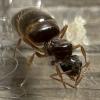Caught in NYC, it's a couple millimeters long. Any ideas what this is?
Edited by Voidley, June 16 2023 - 4:58 AM.

wasp
thank you, any idea what kind it is? I don't really know anything about wasps
Well, it is not a gall wasp and not a Vespidae.
My first thought was fig wasp, but their shape is different.
So we are probably looking at a tiny parasitoid wasp with huge eyes.
And I found this with a little bit of Google-Fu:
https://www.smithson...ural-defenders/
And there I am, thinking again I missed my calling in not becoming an entomologist.
Edited by Ernteameise, June 16 2023 - 1:47 PM.
Once again, I know basically nothing about wasps but from iNaturalist and a brief bit of googling, it might be of the superfamily Ceraphronoidea. By the sound of it though it seems like it's sort of hopeless to know for certain.
Once again, I know basically nothing about wasps but from iNaturalist and a brief bit of googling, it might be of the superfamily Ceraphronoidea. By the sound of it though it seems like it's sort of hopeless to know for certain.
Yeah kind of
"I am here on Earth, and I am only a speck of sand in the desert, a blade of grass in a field. I am no greater than any one of these busy ants who build for each other's comfort. " - King Solomon
Currently keeping: Myrmecocystus Depilis, Pogonomyrmex Rugosus
Wishlist: Camponotus Ocreatus
I've actually been doing quite a bit of work with parasitoids for my entomology job so i think I might be able to narrow it down. This looks like either a eulophid or a pteromalid, which are two very similar looking families. Assuming you still have the specimen best way to figure out which one is to check the tarsal segments on the legs, if there is four its a eulophid while if there is 5 its a pteromalid.
Unfortunately the specimen is long gone. However, out of the two families you listed, I would guess that it is a pteromalid. This is based on this: https://bugguide.net/node/view/18139 which says that eulophids have a "2 to 4-segmented funicle," which I don't think mine has. Additionally, eulophids supposedly "shrivel up badly after death," which my specimen did not. Based on this, I think it's more likely to be from the family Pteromalidae. That said though, I still think that it shares some resemblance with the superfamily Ceraphronoidea. Are you confident that it is one of the two families you mentioned? this is way out of my domain so I could be going about this all wrong. Either way thank you for your input.
0 members, 1 guests, 0 anonymous users